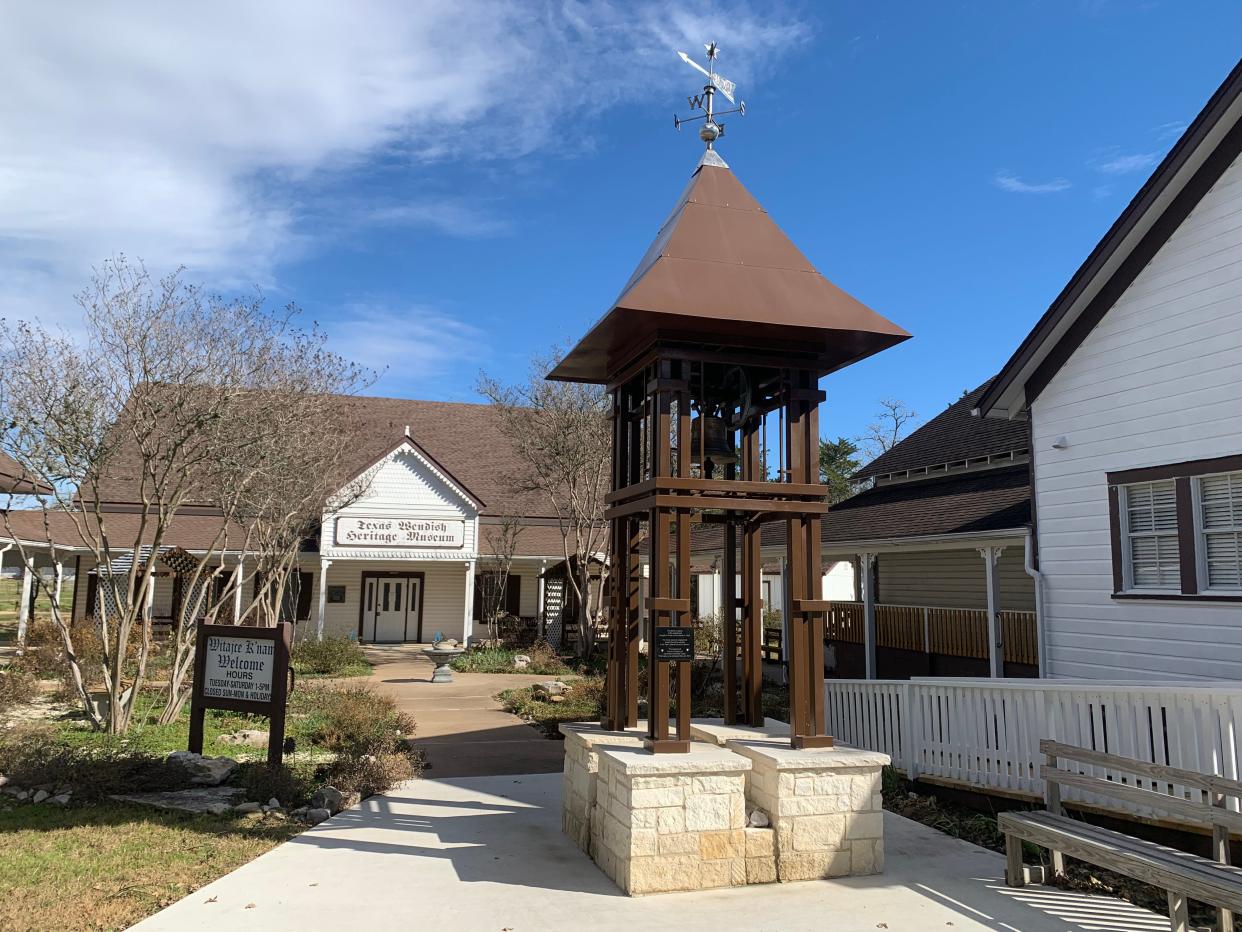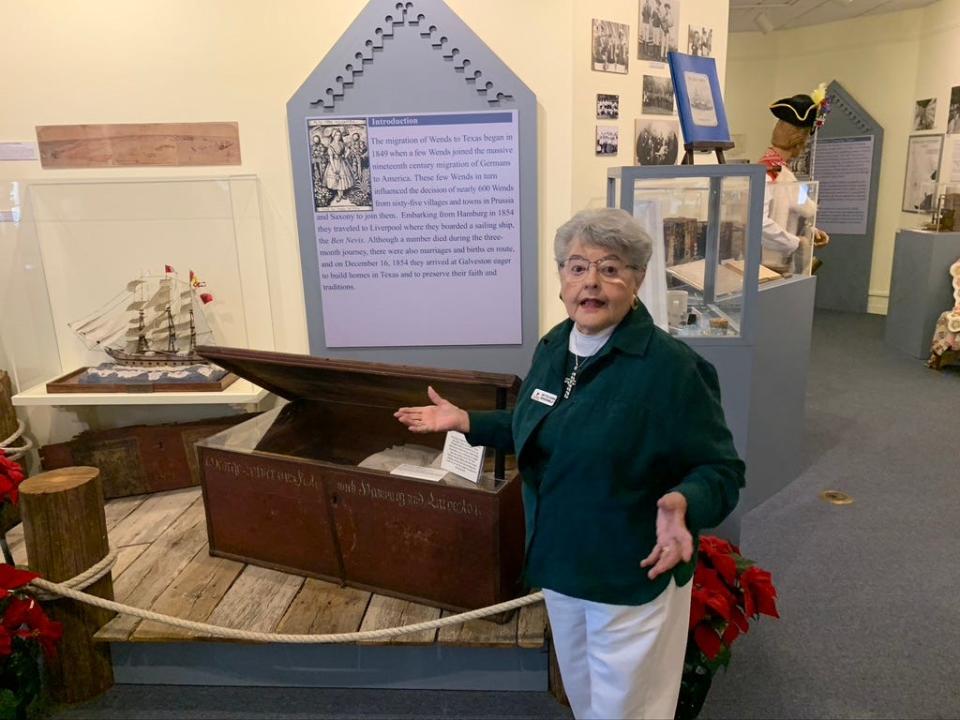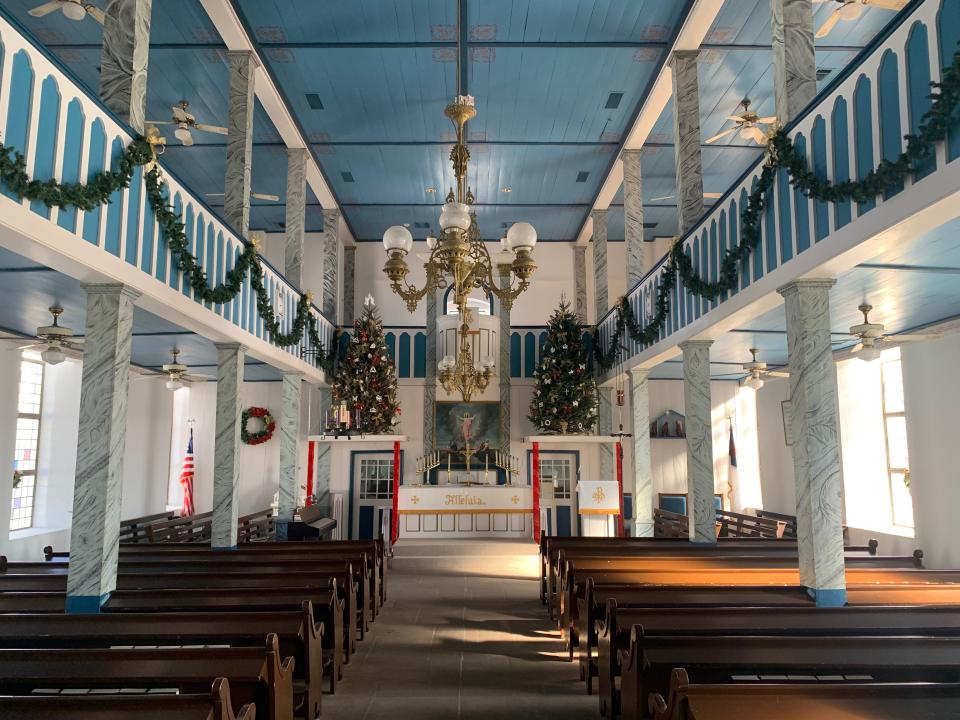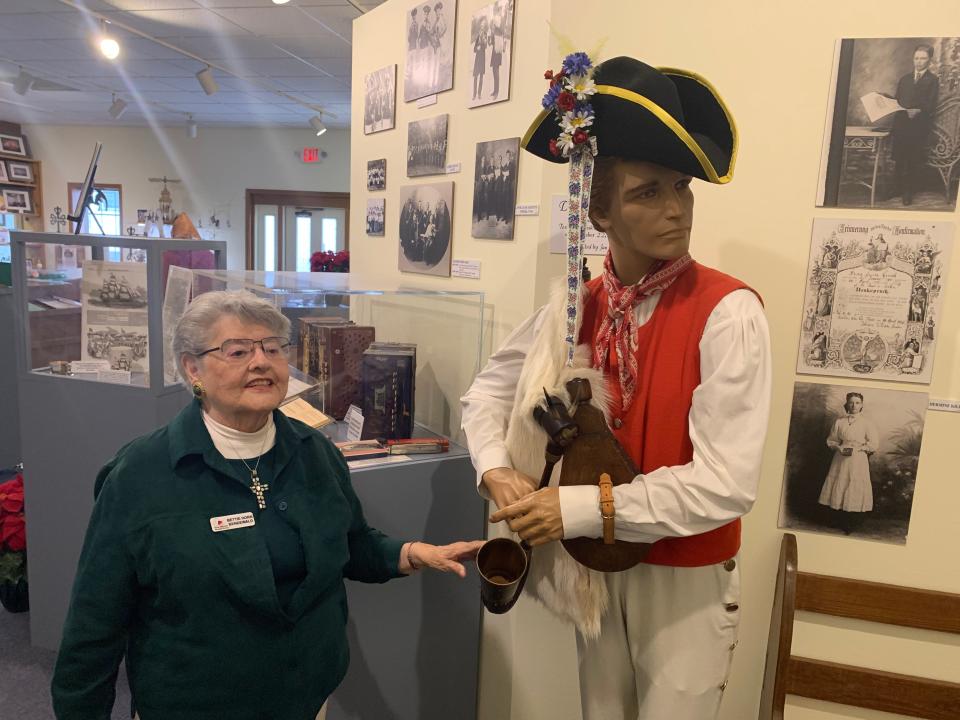Who are the Wends? Find out at one of the best history museums in Texas

SERBIN — I expected quaint.
Instead, the Texas Wendish Heritage Museum in this hamlet of 37 people is smart, illuminating and — rare for a small-town history museum — vital to a living community that could have otherwise lost its identity entirely.
As readers of this column know, I had vowed to visit this oasis of Slavic culture on the rolling, wooded Texas prairies for decades, lured by blue and white painted signs planted along nearby highways.
True to that pledge, on Jan. 4, a day-trip buddy and I signed in as the first official visitors to the museum in 2023.
Where is the Texas Wendish Heritage Museum?
You can't miss the museum complex, which sits on a small rise among pastures and thickets at 1011 County Road 212. Reach that narrow lane from Farm to Market 448, which splits off from U.S. 77 just south of Giddings, the seat of Lee County.
Along the way, check out the Romanesque Revival county courthouse, now under renovation.
In order to estimate drive times, Houston lies a little more than an hour to the east, Austin a little under an hour to the west.
While the hand-painted signs that direct you to the museum are alluring, another one is needed at the intersection of U.S. 77 and FM 448, which is easy to miss if you are not from these parts. Once in Serbin, an unincorporated community of scattered rural buildings, pull into the small, shaded parking area next to the tidy historic cemetery.

Wendish noodles, smart displays and those black wedding dresses
You'll encounter what might be the best small-town historical museum in the state: five carefully curated and interpreted halls easily worth a full hour of your time. The main structure holds the museum offices, gift shop, back shop and the main history exhibits about the Wends in Europe and Texas, told through classy but never stuffy displays and clear, explanatory wall texts.
As you leave the main building, to the right is a long wooden structure that formerly served as home to the St. Paul Lutheran School. Here find immaculately arranged domestic, retail and educational scenes, including one devoted to black wedding dresses.
"It is very Slavic," museum director Chelsea Beck says. "It was to remind them — and everyone else — of the hardships to come in marriage. Eventually they moved on to grey and then, of course, white. There was a brief period where many brides — Wendish or otherwise — wore light blue because Queen Victoria was married in blue."
In one corner near some ornate furniture is a polished musical organ once owned by the ancestors of Austin resident Jean Rather, wife of journalist Dan Rather.
"The media were all over the place when that came in," says tour guide Bettie Horn Bendewald, who sprinkled her docent routine with warm insider humor.
More:'Nobody would ever find him': Stephen F. Austin wanted to retire to what is now Austin
A third building doubles as a gathering hall for visitors, including tour groups who order a Wendish noodle meal in advance. (More on that tasty option later.)
The final two buildings are log structures built in the 1850s. One is in quite good condition and shows how the earliest Wendish settlers lived in Texas, including a corn-husk mattress for the bed; the second, a work room with farm implements, has deteriorated significantly. It has been separated from the domestic building, stabilized and protected under a metal canopy.
Who are the Wends?
The Wends are a Slavic people whose languages — Upper and Lower Sorbian — are related to Czech and Polish. They encountered Germanic tribes more than 1,000 years ago and eventually were absorbed into the German Empire, mostly in Prussia and Saxony. Some Wends assimilated and adopted the German language, so the immigrants arrived speaking both languages. The local newspaper was published in Wendish, German and English.
According to the literature at the museum, the Texas Wends left Europe seeking religious liberty. The Prussian king, annoyed by the multiplying sects of Protestants after the 16th century, endeavored to create a state Protestant religion that incorporated Lutherans, Calvinists, Anabaptists and others.
Strictly Lutheran, the Wends were having none of that.
How the heck did the Wends get to Texas?
About 600 Wends left Europe under the spiritual leadership of Pastor Jan (John) Kilian aboard the ship Ben Nevis. Tragically — but not unusually — 83 of them died en route. The survivors landed in Galveston in 1854. Those who could afford oxen carts left soon for what later became Lee County, while others lingered in Houston, already home to many Lutherans, especially in the Heights district.
Recall that during the previous decade, thousands of Germans, Czechs and others had already made this trans-Atlantic journey from Central and Eastern Europe, landing in New Orleans before transferring to Galveston or Indianola in Texas. Although they lived in this area side-by-side with these immigrants — as well as Anglo-Americans and African-Americans — the Wends held tight to their identities.
Among those identified by trade, many were farmers, but others were masons, potters, cobblers, butchers, bakers, tailors, blacksmiths, millers and cabinet-makers. Not enslavers, according to Bendewald, they fought on both sides of the Civil War, despite a strong pacifist streak among some Wends.
From the coast, the Wends spread west, north and south in Texas. Contemporary Texas Wendish communities can even be found in the Rio Grande and Red River valleys.

There's a church nearby, right?
St. Paul Lutheran Church, dedicated in 1871 to replace the original church, it is not especially extravagant compared with the other painted Lutheran or Catholic churches in this general area. The view from the road of its plain white steeple and somber exterior is partially obscured by modern school buildings.
More:'They changed how the city was built': TxDOT keeps immigrant cemetery near I-35 intact
Yet the interior feels light, elevated and welcoming, especially given the wrap-around choir loft and the pulpit that hangs high above the altar. The blue paint and wavy patterns on the columns — "feather painting" meant to mimic marble — lend it a faintly underwater feel, which carries its own spiritual associations.
Tell me that the historic cemetery is in good shape
It's hard to imagine a more lovingly tended graveyard in Texas. Even the oldest headstones, dating back some 170 years, are upright, clean and, for the most part, legible. Newer granite monuments with crisp lettering adorn many of the same graves and include encased portraits of the deceased.
Particularly touching is a flat, dark stone that memorializes by name and age the 83 men, women and children that did not make it to this spot, many buried at sea. Also find here the family plot of leader Jan Kilian, whose son also served as pastor of this community.

How do the scattered Wends stay in touch?
This is the nerve center for Wends in the New World.
While Wendish is not fluently spoken in Texas, descendants come here to find out about their ancestors and their culture. The museum operates a well-organized archive and keeps regular hours, unusual for small-town Texas archives.
A group called the Wendish Research Exchange — one joins the group by becoming a museum member — actively shares histories, videos, translations, language lessons, blogs, forums and other resources. Find info at wendishresearch.org.
Texas history, delivered to your inbox
Click to sign up for Think, Texas, a newsletter delivered every Tuesday
Thanks to the churches, school, museum, cemetery and research exchange, thousands of Wendish descendants are discovering their heritage. Many of them are moving back into the area and sending their children to St. Paul Lutheran School.
"The Wends started more than 16 Lutheran churches across the state," Beck says. "Many of them are still thriving congregations. Even some of the ones in small communities like this one are packed each Sunday."
What's the connection to Concordia University in Austin?
A big display at the museum explains the origins of Concordia University Texas, which was founded, according to the museum's historians, by the Wendish community in nearby Giddings.
This may ring a bell for Austin readers because the town of Giddings made a major play to regain the university when it sold its property on Interstate 35 north of the University of Texas campus a few years ago. Instead, due partly to a poll of students, but also because of some outrageously good real-estate luck, Concordia instead moved to the 380-acre nature-swathed former Schlumberger campus on FM 620 near Lake Travis.
Early on, Concordia occupied the Schubert Fletcher House near the courthouse in Giddings. That handsome building now serves as the local chamber of commerce and visitor's bureau. (We tried to visit during operating hours, but failed to find an unlocked door.)
The Wends stuck with the school. According to some sources, between 10 and 15 percent of Concordia's faculty, staff and students today are of Wendish heritage.
Bendewald told a special story about attending Concordia in Austin in 1955, the year women were first admitted.
"There were 100 high school boys and 50 college men on campus," she recalls. "And 14 of us women."
Day trips make me hungry: Where can I eat near Serbin?
I can heartily recommend the Bullpen Bar & Grill at 2156 County Road 217, almost due east of the museum. The large, airy room is dominated by a U-shaped bar, enclosed on two sides by dozens of sturdy tables and chairs. Sports broadcasts loom above the long bar, but the noise is not deafening. (Except probably during televised games of nearby schools and universities.)
The Bullpen keeps on tap a dozen or so beers — and more in bottles — as well as wine and hard seltzers. We thoroughly enjoyed our bacon cheeseburger and grilled cheese sandwich, both with fries. The crowd during mid-afternoon was divided between old-timers clustered around the TV screens and workers coming through for a quick beer break.
If you leave the area by way of U.S. 77 south, try Back Porch BBQ, located at the crossroads of U.S. 71 and U.S. 77 in La Grange, where, on an earlier day trip, I carried out a “Back Porch Sandwich,” which I described as "a behemoth (that) enclosed a mountain of sausage and brisket in a hefty bun."
Wait, what's this I hear about Wendish noodles?
Every society worth that name preserves its unique food culture. The centerpiece for many a Wendish meal is a dish of egg noodles. At the museum, they are served with sausages, green beans and sauerkraut for visiting bus groups of 15 or more. Reserve the feast in advance by emailing museum@texaswendish.org, or calling 979-366-2441.
On site, staff members and volunteers make wide trays of these noodles. One can purchase the dried noodles at the museum gift shop, or at stores in Giddings, La Grange, Wharton, Schulenburg, Georgetown and Brenham.
I leave you with the printed Wendish cooking directions: "Bring to a boil 10 cups of chicken broth and, if desired, some butter. Add (1 lb.) noodles, cover and simmer for 15-20 minutes. Remove the pot from the burner and allow to rest, covered, for 20-30 minutes. Do not drain. Eat and enjoy!"
It turns out to be something like chicken noodle soup. If you use homemade stock or good bone broth from a jar, along with these special noodles, make that excellent — and Wendish — chicken noodle soup.
Michael Barnes writes about the people, places, culture and history of Austin and Texas. He can be reached at mbarnes@gannett.com. Sign up for the free weekly Think, Texas digital newsletter at statesman.com/newsletters.
This article originally appeared on Austin American-Statesman: The Wendish culture is kept alive in tiny Serbin, Texas

